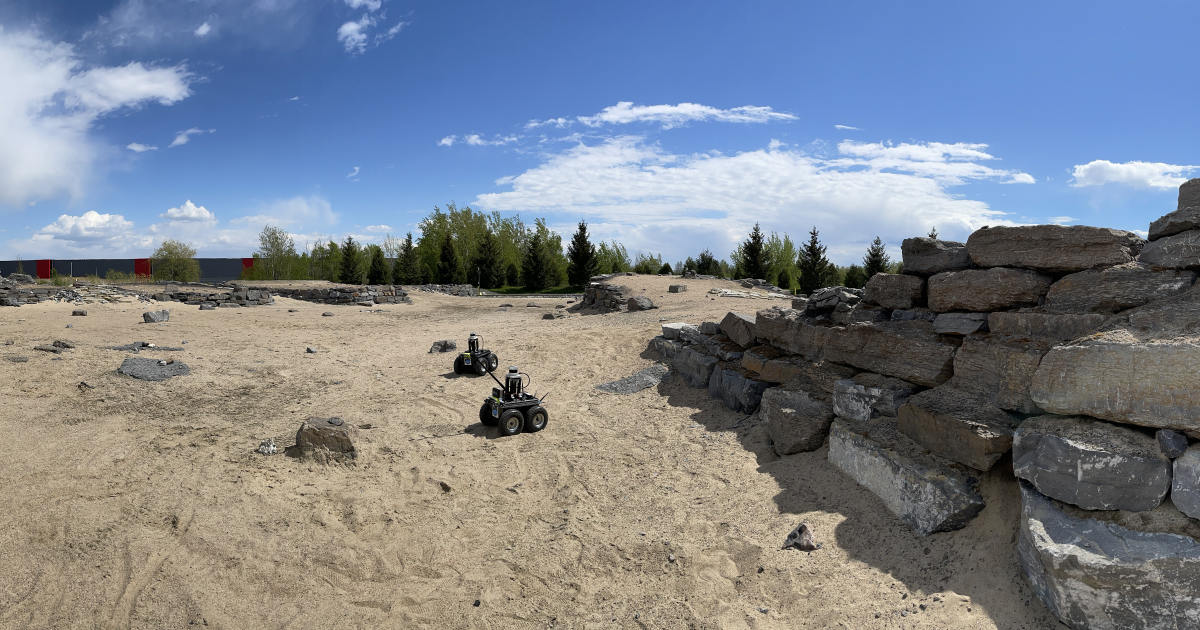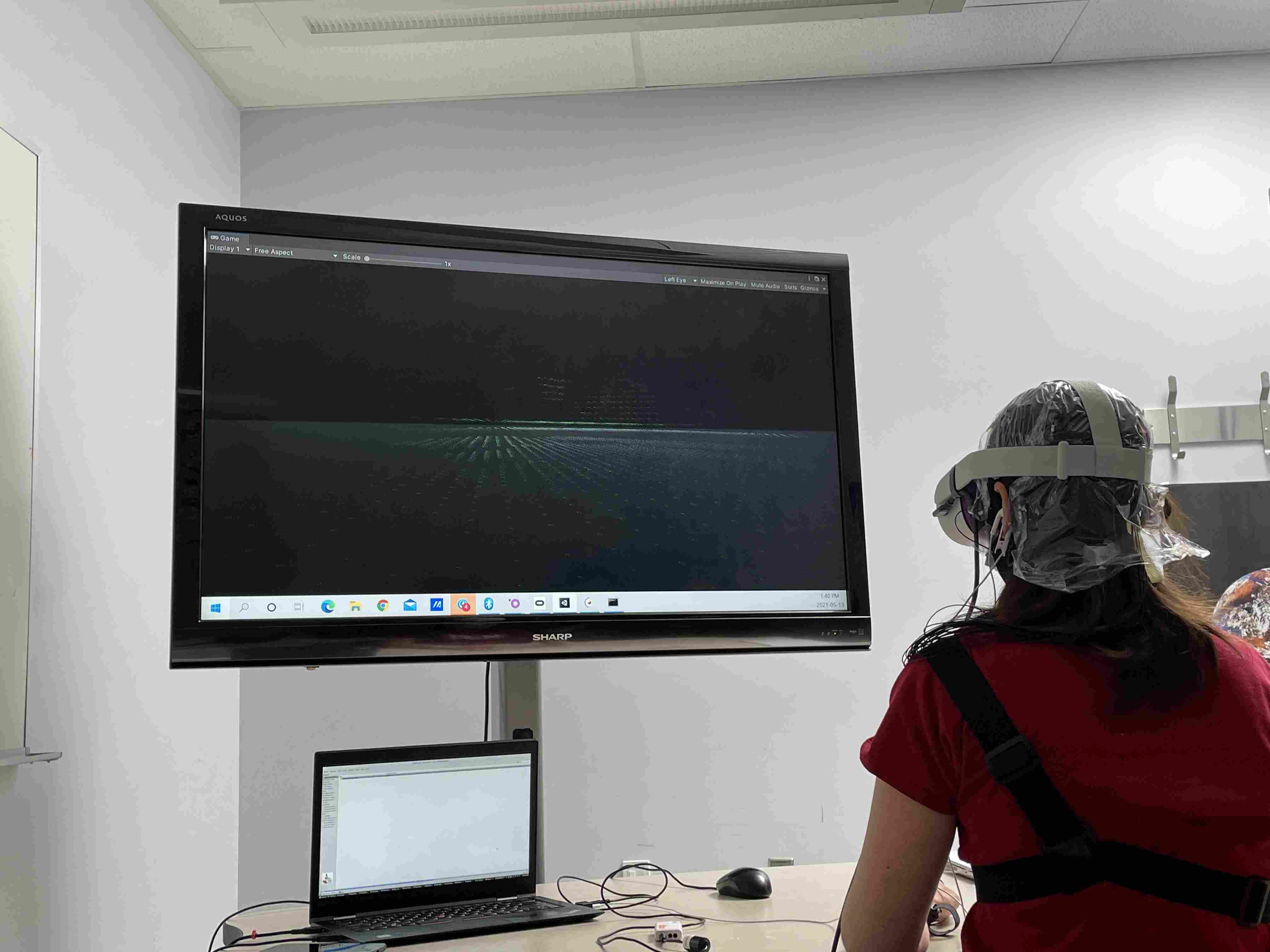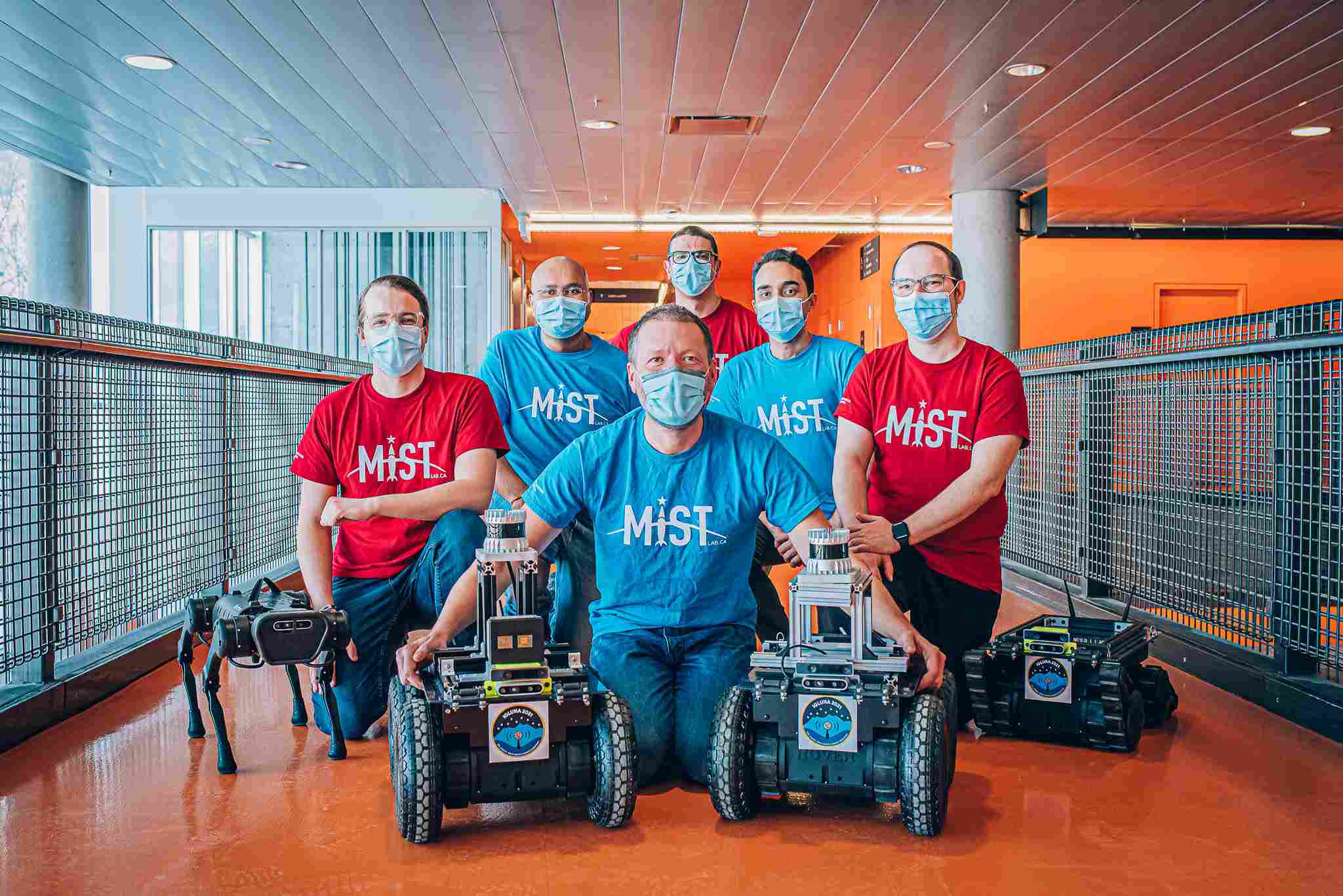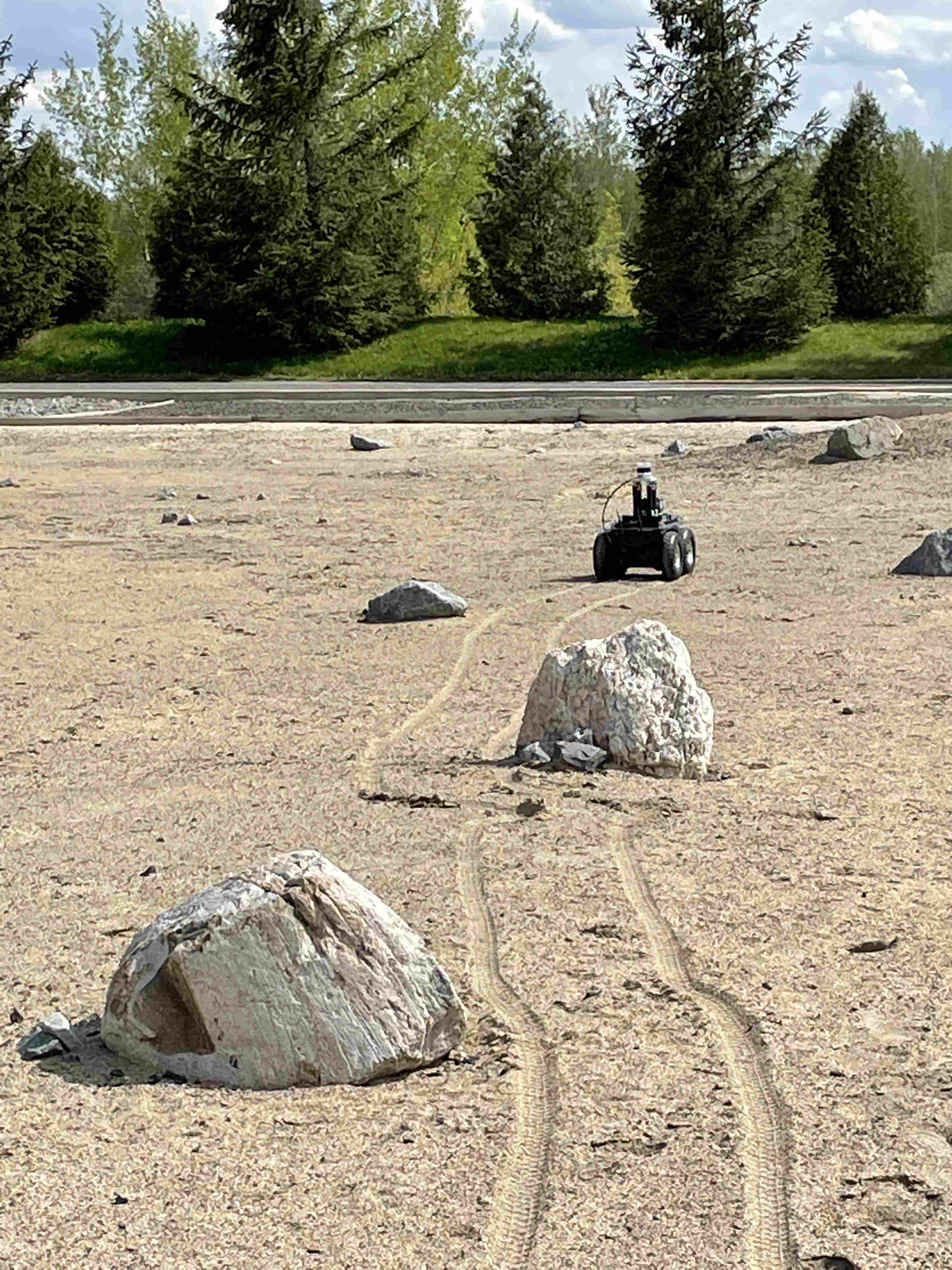Blogue
Roaming robot swarms set to explore Lunar and Martian caves


The swarm of rovers from Polytechnique's MIST Laboratory have mapped a site reminiscent of the Moon and Mars at the Canadian Space Agency. (Photo : Marcel Kaufmann)
If you visit the Polytechnique Montreal campus over the next few days, it's very possible that you'll come across a fleet of busy robot rovers, hard at work. Professor Beltrame's team is carrying out a series of experiments with exploration-focused robots in order to prepare for three training missions planned for the coming months - a prelude to future exploration missions to the Moon and Mars.
They're the size of a microwave oven, but that doesn't stop them from doing a job comparable to that of NASA's large space rovers that have gone to Mars in recent years, courtesy: Sojourner, Spirit and Opportunity, Curiosity and Perseverance.
Yet the main feature of Polytechnique Montréal's MIST Laboratory robots is that they work in a team. In addition to covering a large area in a shorter period of time than a single rover would, being in a team enables each mission to better manage risk.
"If a robot breaks, the others can intervene to compensate for its loss. On the Moon or on Mars, there are no robot repair shops, so it's important to have safety nets," explains Professor Giovanni Beltrame from the Department of Computer and Software Engineering.
But good odds aren’t the only advantage of using a fleet of robots - the Polytechnique Montréal team has robot rovers in a variety of forms. In addition to the now-classic “wheeled” rovers, the research team is testing the exploration skills of a robot dog-style model. Also being assessed is the potential contribution of spherical robots that bounce as they move! The latter is a project developed by an École de technologie supérieure (ÉTS) research team headed by Professor David St-Onge. “Each robot offers unique and complementary functions,” explains Professor Beltrame.
“Some move better on sand, while others can explore hard-to-reach areas like a rocky mound, or a cave. Exploring lunar caves, then Martian caves.
Exploring lunar and martian caves
 Professor Giovanni Beltrame (Photo : Caroline Perron) Professor Giovanni Beltrame (Photo : Caroline Perron) |
Professor Beltrame's team and work take place in a context where lunar exploration missions are resuming. The Canadian Space Agency plans to conduct its own Moon missions within five years.
For its part, NASA is eyeing not only the Moon, but also Mars. The American space organization intends to send a manned flight to Mars during the 2030s but also plans to establish an exploration base on the red planet.
However, before such plans are realized, robots will be dispatched to sites to identify the best spots for human occupation - and that's where teams like Professor Beltrame's come in. "We think that the temperate environment of a cave would be more conducive to the establishment of a base, however, only the collective work of several robots would make it possible to explore and map such a place,” he adds.
So what’s the context? A cave's rock walls block the transmission of signals to Earth, and potentially uneven surfaces increase the risk of needing to abandon an exploration mission - if you send only a single robot. By using a fleet, the risk is distributed over each link in the chain.
Additionally, robots can relay information among themselves to a surface relay that can maintain exchanges with Earth. To achieve this though, robots in a fleet must be able to make decisions on their own, while learning from what their “fellow” robo-explorers are discovering.
Further, they must also be able to adapt to change. So, robot fleets must bet on a collective intelligence, commonly called "swarm intelligence." Artificial intelligence in each robot permits this collective decision-making, and via swarm intelligence, robots work using the principles of a democracy.
Each decision takes the form of a calculation that considers a variety of criterion. "For example, they’ll vote to decide who is in charge of what, taking into account the skills specific to each robot, their power level, their ability to move, and the distance they can cover," says Beltrame, who, in addition to being a professor, is also a former microelectronics engineer at the European Space Agency (ESA). The highest score determines what the decision will be each time; this sort of system is already used in airport control towers and dispatch systems of companies like Uber.
The researcher does admit though, that a democratic system is not infallible, even with robots. As with humans, robots might have a hard time coming to an agreement on how to get the job done. “In space, with limited time, we need a way to resolve conflicts,” he explains. If conflicts arise, there are various options to decide who wins. Generating behavior based on consensus is the essence of our work."
Numerous missions... on the horizon |
|
The MIST Laboratory team was set to travel to Lucerne, Switzerland this month to take part in the IGLUNA 2021 mission. Due to the health and safety guidelines adopted in Switzerland and Canada, the team will ultimately carry out its mission virtually in Quebec. In Switzerland, the robots would have semi-autonomously surved the heights of Mount Pilatus, while communicating their findings with the Polytechnic team stationed 30 km away. The team has already carried out a similar experiment last May on the Canadian Space Agency site in Saint-Hubert, Québec. Over the course of the few training sessions, three rovers surveyed the area, mapped the terrain using lidars to spot obstacles, and generated a map of the location - all of which was monitored remotely by an on-duty team in a small room in Polytechnique Montreal's Pavillon Lassonde. One of the participants even had the task of orienting the fleet of robots towards points of interest. Professor Beltrame was satisfied with the results of this first “real test,” which made it possible to validate the functionality of the ad hoc communication network the robots use. “The start of the week was difficult, but we managed to make everything work - which was something very important aspect to consider, because there's no Wifi or cellular network on the Moon or on Mars," notes Beltrame. Once the IGLUNA mission is complete, the group will conduct two new cave trials - one in the United States, and the other in the Canary Islands. |
Attention, Attention!
 Using a virtual reality headset and a heart rate monitor, Concordia University's Psychology Professor Emily BJ Coffey piloted the fleet of robots during tests conducted last May in collaboration with the Canadian Space Agency. (Photo : Marcel Kaufmann)
Using a virtual reality headset and a heart rate monitor, Concordia University's Psychology Professor Emily BJ Coffey piloted the fleet of robots during tests conducted last May in collaboration with the Canadian Space Agency. (Photo : Marcel Kaufmann)
In addition to communication between robots, the MIST lab team is also looking at communication involving a human controller. What level of attention is required by the operator controlling a fleet of robots? This is one of the questions that Marcel Kaufmann, a doctoral student under Professor Beltrame's supervision, is trying to answer.
By monitoring the heart rate as well as pupil dilation of the individual directing the robots, the MIST team also wants to ensure that the robots “understand” when it's best not to disturb the controller by "asking a question."
"We also want to determine what the maximum workload is for an individual who leads this kind of mission," says Kauffman, who collaborates with Concordia University's Professor of psychology Emily BJ Coffey.
we're... recruting! |
 The lab is recruting. For more information, see the following link.
|
learn more
Professor Giovanni Beltrame expertise
Department of Computer Engineering and Software Engineering website
MIST Lab website
2021 IGLUNA campain website







Comments
Commenter
* champs obligatoire